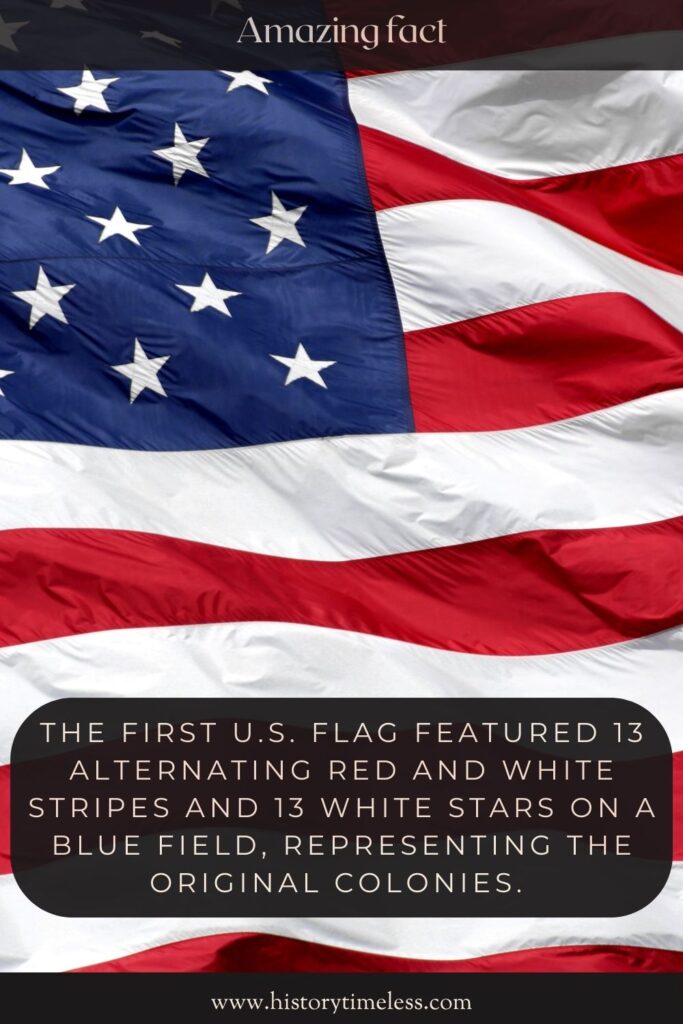America, the land of the free and the home of the brave, is a country rich in history, culture, and fascinating quirks. From its iconic landmarks to its diverse traditions, the United States never fails to surprise.
Whether you’re a history buff, a travel enthusiast, or just curious about fun facts, this list will take you on a journey through some of the most interesting and lesser-known aspects of America. Did you know the U.S. has no official language?
Or that it’s home to the world’s largest pizza chain? Buckle up as we explore 30 unique, relatable, and engaging facts about the USA!
1. The U.S. Has No Official Language
While English is the most widely spoken language in America, the United States has no official language at the federal level. This reflects the nation’s history of immigration and cultural diversity. Over 350 languages are spoken across the country, with Spanish, Chinese, and Tagalog among the most common.
Some states, like Hawaii, have even recognized additional official languages (Hawaiian). This linguistic variety highlights America’s melting pot identity, where communities preserve their heritage while embracing a shared national culture.
2. America’s National Park System Is Massive
The U.S. boasts 63 national parks, covering over 84 million acres of protected land. From the geysers of Yellowstone (the world’s first national park) to the Grand Canyon’s breathtaking vistas, these parks preserve natural wonders and wildlife.
The National Park Service, established in 1916, welcomes over 300 million visitors annually. Whether it’s hiking, camping, or stargazing, these parks offer endless adventures and play a vital role in conservation efforts, ensuring future generations can enjoy America’s stunning landscapes.
3. The Liberty Bell Has a Famous Crack
One of America’s most iconic symbols, the Liberty Bell, cracked during a test ring in 1752—shortly after its arrival in Philadelphia. Despite repairs, the bell cracked again in the 1840s and has remained untouched since.

Weighing over 2,000 pounds, it originally rang to summon lawmakers and citizens for important announcements. Today, it symbolizes freedom and independence, drawing millions of visitors yearly. The crack only adds to its charm, making it a unique piece of American history.
4. The U.S. Invented the Internet
The internet, a global revolution, traces its roots to the U.S. Department of Defense’s ARPANET in the 1960s. Designed for secure communication during the Cold War, it evolved into the World Wide Web we know today.
American innovators like Vint Cerf and Tim Berners-Lee played pivotal roles in its development. Now, the internet connects billions worldwide, transforming commerce, education, and social interaction. This groundbreaking invention underscores America’s influence on modern technology.
5. Alaska Is the Largest State by Far
Alaska, purchased from Russia in 1867 for $7.2 million, is the largest U.S. state—over twice the size of Texas! Its vast wilderness includes glaciers, forests, and abundant wildlife like grizzly bears and moose. Despite its size, Alaska has the lowest population density in the country.
The state’s extreme daylight variations (24-hour sunlight in summer, darkness in winter) make it uniquely fascinating. Often called “The Last Frontier,” Alaska remains a land of adventure and natural beauty.
6. The Great Lakes Hold 20% of Earth’s Freshwater
The five Great Lakes—Superior, Michigan, Huron, Erie, and Ontario—form the largest freshwater system on Earth. Holding 6 quadrillion gallons of water, they span over 94,000 square miles, bordering eight U.S. states and Canada.
These lakes support ecosystems, shipping routes, and recreation. Lake Superior alone could cover North and South America in a foot of water! Their sheer size and importance make them a vital natural resource for millions.
7. The First Pizza Chain Was Founded in America
While pizza originated in Italy, the first pizza chain, Pizza Hut, was founded in Wichita, Kansas, in 1958. Today, the U.S. is home to over 75,000 pizzerias, with Americans consuming 3 billion pizzas annually.
From New York’s thin crust to Chicago’s deep-dish, regional styles reflect the nation’s culinary creativity. The rise of delivery and frozen pizza further cemented its status as a beloved American staple.
8. The U.S. Has the World’s Longest Border
Stretching 5,525 miles, the U.S.-Canada border is the longest international boundary in the world. It crosses diverse landscapes, from the Rocky Mountains to the Great Plains. Remarkably, it’s also the world’s “friendliest” border, with minimal military presence.
The Peace Arch monument between Washington and British Columbia symbolizes this peaceful relationship. Meanwhile, the U.S.-Mexico border, at 1,954 miles, is the most frequently crossed international boundary globally.
9. The Bald Eagle Almost Went Extinct
America’s national bird, the bald eagle, was nearly wiped out in the 20th century due to hunting and pesticides like DDT. By 1963, only 417 nesting pairs remained. Conservation efforts, including the Endangered Species Act, helped populations rebound.
Today, over 300,000 bald eagles soar across the U.S., symbolizing resilience and environmental success. Their recovery is a testament to wildlife protection laws and public awareness.
10. The Statue of Liberty Was a Gift from France
A symbol of freedom and democracy, the Statue of Liberty was gifted by France in 1886 to commemorate America’s centennial and Franco-American friendship. Designed by Frédéric Auguste Bartholdi, its copper exterior has weathered to a iconic green patina.
Over 4 million visitors climb her crown annually for stunning NYC views. The statue’s torch and tablet (inscribed with the Declaration of Independence’s date) represent enlightenment and liberty.
Great! Here are 10 more fascinating facts about America, following the same format:
11. The U.S. Has the World’s Largest Economy
The United States has held the title of the world’s largest economy since the late 19th century, with a GDP exceeding $25 trillion. Its economic strength stems from diverse industries, including technology, finance, agriculture, and entertainment.
Silicon Valley, Wall Street, and Hollywood are global powerhouses driving innovation and culture. Despite challenges, America’s economy remains resilient, supported by entrepreneurship, natural resources, and a skilled workforce. This economic dominance influences global trade, politics, and technological advancements.
12. There’s a Town Named “Boring” in America
Located in Oregon, the town of Boring was named after William H. Boring, a Civil War veteran who settled there. Ironically, the town embraces its name with slogans like “The most exciting place to live.” In 2013, it partnered with Dull, Scotland, to promote tourism as “sister communities.”
Quirky town names like this (e.g., Truth or Consequences, NM, and Intercourse, PA) add charm to America’s map, proving that even the “boring” places have character.
13. The U.S. Has More Airports Than Any Other Country
With over 13,000 airports, the U.S. has the world’s largest aviation infrastructure. Major hubs like Atlanta’s Hartsfield-Jackson and Chicago O’Hare handle millions of passengers annually. General aviation is also huge—over 5,000 public airports cater to private planes.
This vast network reflects America’s size, reliance on air travel, and historical role in aviation (the Wright brothers’ first flight happened here!). Whether for business or leisure, flying is deeply ingrained in American life.
14. The Declaration of Independence Has a Hidden Message
Some historians believe the Declaration of Independence has a reverse-side message: “Original Declaration of Independence dated 4th July 1776.” This isn’t a secret code but likely a label added during its 19th-century storage.
The document itself, housed in the National Archives, is meticulously preserved. Its famous preamble (“We hold these truths…”) remains a global symbol of liberty. Fun fact: Only 26 known copies of the original 1776 printing exist today!
15. America’s Interstate Highway System Is Longer Than Earth’s Circumference
The U.S. Interstate Highway System spans 46,876 miles—longer than Earth’s circumference (24,901 miles)! Begun in 1956 under President Eisenhower, it revolutionized travel, commerce, and military logistics.
Highways like I-90 (Boston to Seattle) and I-10 (LA to Jacksonville) connect coasts seamlessly. The system’s design includes straight sections for emergency airplane landings. Love it or hate it, road trips are a quintessential American experience thanks to this engineering marvel.
16. The First American Flag Had 13 Stars and Stripes
Designed by Betsy Ross (according to legend), the first U.S. flag featured 13 alternating red and white stripes and 13 white stars on a blue field, representing the original colonies.

The current 50-star version debuted in 1960 after Hawaii joined the Union. Flag Day (June 14) celebrates its history, though it’s not a federal holiday. Fun fact: The flag has been redesigned 27 times to reflect new states!
17. The U.S. Consumes the Most Coffee Worldwide
Americans drink about 400 million cups of coffee daily—more than any other nation. The obsession dates to the Boston Tea Party, when coffee replaced tea as a patriotic beverage.
Today, chains like Starbucks (founded in Seattle) fuel the $100 billion U.S. coffee industry. From pumpkin spice lattes to cold brew, coffee culture is deeply embedded in work, social life, and even politics (the “coffee caucus” in Congress!).
18. Mount Rushmore Was Almost Very Different
The iconic Mount Rushmore originally planned to feature full-body sculptures of presidents, but budget constraints limited it to heads. Sculptor Gutzon Borglum also wanted to include Thomas Jefferson’s draft of the Declaration of Independence in a hidden chamber.
The project took 14 years (1927–1941) and used dynamite to carve 60-foot faces. Despite controversy over its location on sacred Lakota land, it draws 2 million visitors yearly as a symbol of American ambition.
19. The U.S. Has More Tornadoes Than Any Country
America’s “Tornado Alley” (Texas to South Dakota) sees over 1,200 tornadoes annually—the most worldwide. This results from clashing warm Gulf and cold Canadian air masses. The deadliest was the 1925 Tri-State Tornado, killing 695 people. Modern forecasting and storm shelters have reduced fatalities, but tornadoes remain a fearsome force. Films like Twister and storm-chasing tourism highlight their cultural impact.
20. Hollywood Produces Over 700 Films Annually
The U.S. film industry, centered in Hollywood, dominates global cinema. California’s ideal weather and diverse landscapes made it a filming hotspot in the early 1900s. Today, “Bollywood” (India) makes more films, but Hollywood’s blockbusters (Marvel, Star Wars) earn billions worldwide.
The Oscars, held in LA since 1929, are cinema’s most prestigious awards. Fun fact: The first movie theater opened in Pittsburgh in 1905!
21. The White House Has 132 Rooms
The iconic presidential residence contains far more than just the famous Oval Office. With 132 rooms spread across six floors, the White House includes 35 bathrooms, 28 fireplaces, 8 staircases, and even a bowling alley. The building requires 570 gallons of paint to cover its exterior.
First occupied by John Adams in 1800, it has survived fires (during the War of 1812) and numerous renovations. The West Wing was added in 1902 to accommodate growing presidential staff. Today, it serves as both home and workplace for America’s commander-in-chief.
22. America’s Tallest Mountain Is Actually Underwater
While Denali in Alaska (20,310 feet) is the highest peak above sea level, Hawaii’s Mauna Kea is taller when measured from base to summit. This dormant volcano extends about 33,500 feet from its underwater base in the Pacific Ocean, with 13,796 feet above water.
If measured this way, it surpasses Mount Everest by over 4,000 feet! The mountain is sacred in Hawaiian culture and home to world-class astronomical observatories that take advantage of its clear skies and minimal light pollution.
23. The U.S. Has More Golf Courses Than Any Other Country
With over 16,000 golf courses, America contains about 45% of the world’s total. Florida alone has more than 1,250 courses. The sport became popular in the early 20th century, with iconic courses like Augusta National (home of The Masters) becoming cultural landmarks.
Public figures from presidents to celebrities have helped maintain golf’s popularity. Interestingly, the first golf club in America was established in Charleston, South Carolina, in 1786 – just years after the Declaration of Independence!
24. There’s a Town Where It’s Illegal to Die
In Longyearbyen, Norway’s Svalbard archipelago (a territory with an American connection), dying has been technically illegal since 1950. But America has its own version in Barrow, Alaska (now Utqiaġvik). The permafrost prevents bodies from decomposing properly, creating public health concerns.
While not strictly “illegal,” the town lacks a cemetery, and terminally ill patients are typically flown elsewhere. This unusual law highlights how extreme environments shape local regulations in America’s most remote communities.
25. The U.S. Has More Serial Killers Than Any Other Nation
With over 3,000 documented cases, America accounts for about 67% of the world’s known serial killers. The FBI attributes this to factors like geographic mobility, media influence, and societal isolation. Famous cases like Ted Bundy and Jeffrey Dahmer have spawned countless books and films.
The term “serial killer” was actually coined by FBI agent Robert Ressler in the 1970s. While disturbing, this statistic reflects America’s unique combination of forensic science advancement and cultural fascination with true crime.
26. The Liberty Bell Last Rang on Washington’s Birthday
Contrary to popular belief, the Liberty Bell didn’t crack on July 4, 1776. It last rang (and cracked irreparably) on February 22, 1846, for George Washington’s birthday celebration. The bell was originally cast in 1751 to commemorate Pennsylvania’s constitution.
Its famous inscription (“Proclaim Liberty Throughout All the Land”) comes from the Bible (Leviticus 25:10). Today, the bell is tapped (not rung) on special occasions by descendants of signers of the Declaration of Independence.
27. America Has a National Christmas Tree That’s Alive
Since 1923, the U.S. has had a living National Christmas Tree on the White House Ellipse. Unlike the decorated tree inside the White House, this outdoor tree remains planted year-round. The current Colorado blue spruce was planted in 2012 after its predecessor died.
The lighting ceremony, typically led by the president, features musical performances and has been broadcast nationally since 1954. This tradition blends environmental awareness with holiday celebration in uniquely American fashion.
28. The U.S. Military Has More Aircraft Carriers Than All Other Nations Combined
America’s naval dominance is exemplified by its 11 active aircraft carriers – more than all other countries have collectively. Each Nimitz-class carrier weighs about 100,000 tons and carries 75+ aircraft. The USS Gerald R. Ford, commissioned in 2017, cost $13 billion and is the world’s largest warship.
This naval power projection allows rapid global response and has been key to U.S. military strategy since World War II. No other nation operates more than two carriers of comparable size.
29. There’s an American Town That Celebrates New Year’s at 9 PM
Every December 31, the small town of Eastport, Maine, celebrates the “First Sunrise in the U.S.” by ringing in the new year at 9 pm EST. Located at the easternmost point of the country, they’re the first to see dawn (though technically Alaska’s Aleutian Islands are further east).
The quirky tradition includes a sardine drop (honoring the local fishing industry) and draws visitors seeking a head start on celebrations. It’s one of many unique local traditions that showcase America’s regional diversity.
30. The U.S. Has a River That Flows Backward
The Chicago River is the only American river permanently reversed by human engineering. In 1900, engineers constructed a canal to redirect its flow away from Lake Michigan (the city’s drinking source) to prevent sewage contamination.
The 28-mile system now flows toward the Mississippi River watershed. This monumental project helped control disease and supported Chicago’s growth. Today, the river is dyed green every St. Patrick’s Day, blending engineering prowess with civic celebration in true American style.
Expand your knowledge with more fun facts:
25 Epic Facts That Will Leave You Stunned!
25 Random Animal Facts That Sound Fake but Aren’t!
15+ Thrilling Facts About People Born in December
20+ Insane Facts About Animals That Defy Belief!





